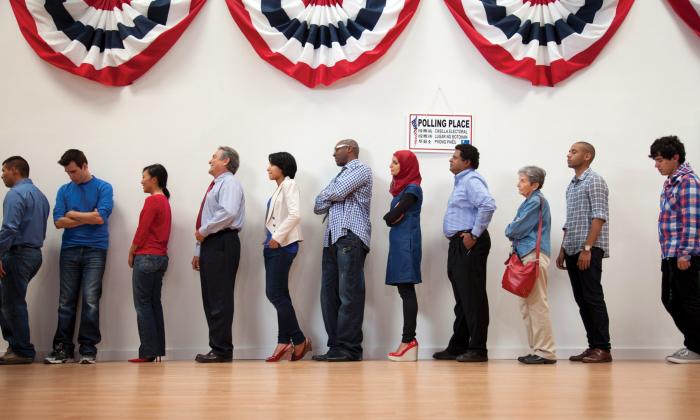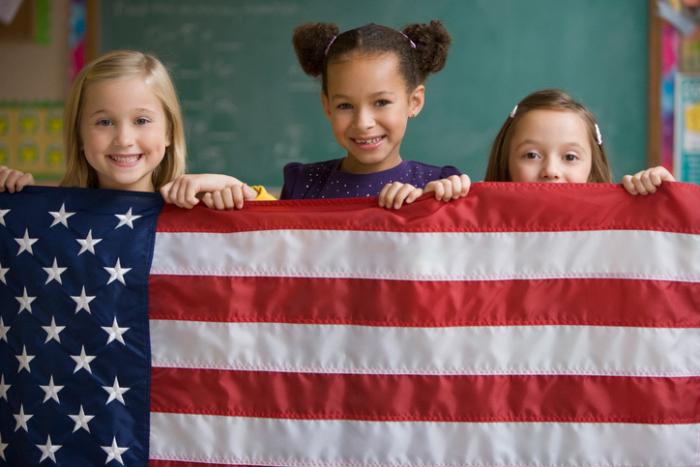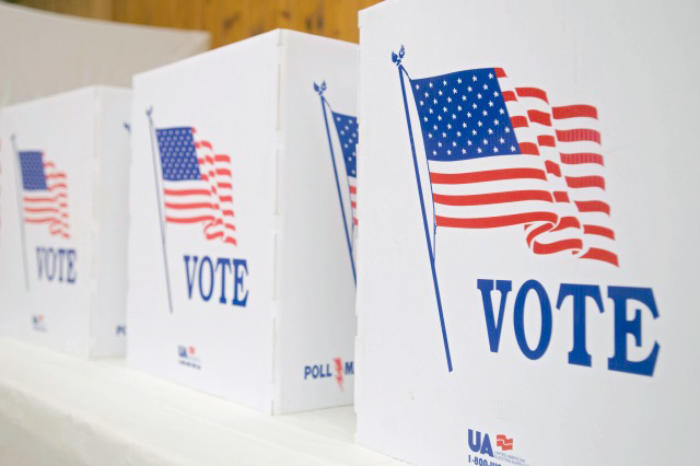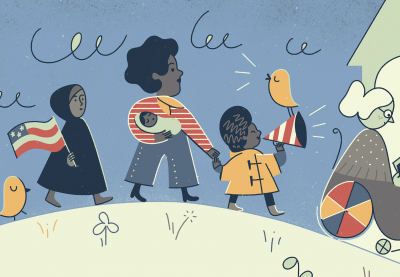The United States is a diverse democracy. That means that each election and policy debate engages a diverse electorate as well as the hearts and minds of students. In K–12 education, it is critically important that students learn about voting and elections, and develop the civic competencies to fully engage in the democratic process—whether that is at the community, local, state or national level.
The Future Voters Project
Teaching Tolerance is proud to announce the Future Voters Project. Check out our suite of free resources for teaching the 2020 election, including a lesson bank for teaching about voter suppression, a growing collection of “teach this” discussion guides for engaging current events with your students, a set of professional development resources for teaching in a time of unprecedented partisanship, recommendations for safe, inclusive voter registration, and more.
In the face of political polarization, students must have opportunities to practice how to engage with people and ideas across difference. That being said, schools need to be places that champion civility, equal rights, safety and civic action for social change.
The collection of resources below—organized by the themes Countering Bias, Civic Activities, Getting Along and How To—offers a range of resources for engaging students on some of our most pressing societal issues.
Teach for a diverse democracy. Teach for a diverse electorate.
Countering Bias
These resources will help students recognize and respond to bias against immigrants, Muslims and Sikhs.
Ten Myths About Immigration
Unravel misconceptions about immigrants and immigration with this short list. (middle and high school)
Using Photographs to Teach Social Justice: Exposing Anti-Immigrant Sentiment
This structured lesson helps students analyze hot-button media messages safely and expertly. (middle and high school)
An Educator’s Guide to the Immigration Debate
The guide and accompanying toolkit provide background knowledge and tips for teaching about the history of immigration in the United States. (high school)
Julia Moves to the United States
In this story, younger students will read about Julia’s experience immigrating to the United States. Includes a a student interview activity. (elementary school)
In a Time of Islamophobia, Teach With Complexity
Learn about a free curricular resource on the Middle East and North Africa from two of its co-authors. (high school)
Countering Islamophobia Through Education
Schools and communities must work together to counter Islamophobia, bullying and hate in all its forms. This curricular resource can help. (middle and high school)
Extreme Prejudice
Grow your students’ religious literacy and understanding of extremism. Includes a toolkit with student activities and a related webinar. (high school)
What Is the Truth About American Muslims?
This guide will answer your students’ questions about Sharia law, religious clothing and whether Islam is a political movement. (high school and adult)
Religious Diversity Webinars
We teamed up with the Tanenbaum Center for Interreligious Understanding to produce a webinar series for teaching about religion across grade levels. The series offers webinars for elementary, middle school and high school educators. (professional development)
Common Religious Clothing
In this lesson, students will explore how articles of clothing are linked to different religions. (elementary)
Understanding Religious Clothing
This lesson help students learn the significance of traditional religious clothing and its meaning to the people who wear it. (middle and high school)
Zahrah’s Hijab
To inspire your students’ empathy, share the story of how Zahrah responded to teasing about her hijab. (elementary)
Sikh Eyechart for America
Sikh cartoonist Vishavjit Singh uses art and humor to challenge people to see the person beneath the turban.

Civic Activities
It’s important to reassure students that they can make a difference in the political process. These resources recommend ways young activists can participate in civic life and do something about the issues that matter to them.
Voting in Your Town
This action-based task includes teacher instructions, student handouts and a rubric. (middle and high school)
Rock the Vote
This story from the Fall 2016 issue of Teaching Tolerance explains how teachers can involve students in the democratic process—even under the age of 18. (high school)
The Young and the Registered
This story profiles organizations dedicated to voter registration and mobilization and discusses how to inspire the next generation of voters. Includes a related webinar. (high school)
Do Something Tasks
Do Something performance tasks allow students to build civic engagement awareness and demonstrate their critical literacy skills. (all grades)
Selma: The Bridge to the Ballot Viewer’s Guide
Included with the Selma film kit, this viewer’s guide provides background information, discussion questions and lessons. (middle and high school)
Rock the Vote’s Democracy Class
This interactive lesson plan includes a mock election exercise to equip young people with the skills they need to navigate the political process. (middle and high school)
League of Women Voter’s Voter Registration Training
This manual includes a step-by-step guide to help you develop successful high school voter registration programs. (high school)
Campus Vote Project’s Student Guides
With this interactive map of the United States, students can see state-specific guides on how to register and cast a ballot. (high school and higher education)
SPLC on Campus
Through student-led SPLC on Campus clubs, the Southern Poverty Law Center is working to make a difference on campuses across the United States. (higher education)
The New Deciders
This episode of America by the Numbers with Maria Hinojosa explores the voting power of four demographic groups: black millennials, Arab Americans, Latino evangelicals and Asian Americans. The accompanying lesson urges students to research and support voting in their communities. (grades 6-12)

Getting Along
While students may not always agree, they should be able to listen, express opinions and debate with respect. These resources can help you guide students in their discussions and model civil discourse.
Mix It Up at Lunch Day
A national campaign launched by Teaching Tolerance in 2002, Mix It Up at Lunch Day encourages students to identify, question and cross social boundaries while sharing a meal. We ask schools to participate on the last Tuesday in October each school year. (all grades)
Polarized Classrooms
This article from the Fall 2016 issue of Teaching Tolerance discusses the divisiveness of political parties and the negative effects of shutting out the other side. (all grades)
Civil Discourse in the Classroom
This lesson booklet provides tools for teaching civil discourse and giving students the skills to turn their opinions into reasoned arguments. (middle and high school)
Speaking Kindness in Democratic Classrooms
This lesson invites students to co-develop a set of guidelines for speaking to each other with kindness and respect. (all grades)
A New Set of Rules
Use this plan to develop a "Class Constitution" with students, furthering their civic education and giving them ownership of the room's rules. (professional development)
Classroom Culture
Foster a classroom culture that reflects diversity, equity and justice by following these five guidelines. (professional development)

How To
Educators are looking for ways to address polarized school and classroom climates. Use these resources to facilitate vital conversations with students about how they see political differences influencing civic life.
School Administrators: Are You Ready?
Teaching Tolerance Director Maureen Costello offers several suggestions for how administrators can keep schools safe after the election. (professional development)
PD Café
These professional development activities from the Fall 2016 issue of Teaching Tolerance help educators process their thoughts about the election and commit to civil discourse and civic engagement. (professional development)
Teach 2016
This feature from the Fall 2016 issue of Teaching Tolerance addresses five common questions and concerns educators have about teaching the election. (professional development)
Political Discussion Belongs in Our Classroom
Read about one teacher’s belief that classrooms should be a safe space for expressing political opinions. (all grades)
Responding to Hate and Bias at School
Find guidance on making school a place where every student feels welcome, and check out the related webinar. (all grades)
Shifting Out of Neutral
A history teacher discusses leaving the struggle for objectivity behind and encouraging students to consider multiple perspectives. (all grades)
Let’s Talk!
Use these strategies as you prepare to facilitate difficult conversations about the election, social inequality, discrimination or other topics. Check out the related webinar. (all grades)
Speak Up At School
This guide offers advice about how to respond to biased remarks and provides guidance for helping students learn to speak up as well. Check out the related webinar. (all grades)
Guidelines for Discussing Difficult or Controversial Topics
Learn how to structure complex conversations about hot-button issues with these strategies from the University of Michigan’s Center for Research on Learning and Teaching (CRLT). (higher education)
Guidelines for Discussing Incidents of Hate, Bias, and Discrimination
Use these strategies from the University of Michigan’s CRLT to facilitate respectful classroom discussion around incidents and behaviors that express hostility or violence. (higher education)
The News Literacy Project
Help students become informed citizens with these educational resources created by teachers and seasoned journalists. (middle and high school)
Photographs by Corbis and Getty Images
